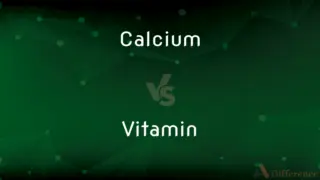Cardiac Muscle vs. Skeletal Muscle — What's the Difference?
By Maham Liaqat & Urooj Arif — Published on November 14, 2024
Cardiac muscle is involuntary and found only in the heart, while skeletal muscle is voluntary and attached to bones.

Difference Between Cardiac Muscle and Skeletal Muscle
Table of Contents
ADVERTISEMENT
Key Differences
Cardiac muscle cells are interconnected by intercalated discs, facilitating synchronized contractions necessary for heart function. In contrast, skeletal muscle fibers are organized into bundles and are controlled voluntarily for movement and posture.
The cardiac muscle operates with an intrinsic rhythm influenced by the autonomic nervous system, enabling the heart to beat continuously without conscious effort. On the other hand, skeletal muscles require direct signals from the nervous system to contract, allowing for conscious control of movements.
Cardiac muscle is highly resistant to fatigue due to its reliance on aerobic respiration and a constant supply of oxygen. Whereas skeletal muscle can operate both aerobically and anaerobically, leading to fatigue when oxygen supply is insufficient during intense activities.
The regeneration capacity of cardiac muscle is very limited, as it is composed of terminally differentiated cells that do not readily proliferate. Conversely, skeletal muscle has a higher capacity for repair and regeneration due to the presence of satellite cells that can differentiate into muscle fibers.
Cardiac and skeletal muscles exhibit different structural proteins and enzymes, reflecting their specialized functions. For instance, cardiac muscle contains unique forms of troponin, which is sensitive to calcium levels, whereas skeletal muscle utilizes a different form that responds to neural stimulation.
ADVERTISEMENT
Comparison Chart
Control
Involuntary
Voluntary
Location
Heart only
Attached to bones
Fatigue Resistance
High
Varies (high in slow-twitch fibers, low in fast-twitch fibers)
Regeneration Capacity
Limited
Higher
Metabolism
Primarily aerobic
Aerobic and anaerobic
Compare with Definitions
Cardiac Muscle
Specialized connections between cells.
Intercalated discs ensure heart cells contract in unison.
Skeletal Muscle
Organized for movement.
Skeletal muscles contract to move limbs.
Cardiac Muscle
Functions without conscious control.
The heart beats automatically due to cardiac muscle.
Skeletal Muscle
Can repair and grow.
Skeletal muscles can heal and grow stronger with exercise.
Cardiac Muscle
Cells work together seamlessly.
Cardiac muscle's synchronization maintains consistent heartbeats.
Skeletal Muscle
Can work with or without oxygen.
Sprinting relies on skeletal muscle's anaerobic capabilities.
Cardiac Muscle
Uses oxygen for energy.
Cardiac muscle relies on continuous oxygen supply.
Skeletal Muscle
Controlled by conscious thought.
Choosing to lift a weight uses skeletal muscle.
Cardiac Muscle
Cannot easily repair itself.
Heart damage is often permanent because cardiac cells don't regenerate well.
Skeletal Muscle
Requires nerve signals.
Moving your hand requires a neural signal to skeletal muscles.
Common Curiosities
How do skeletal muscles move the body?
By contracting in response to voluntary signals from the nervous system.
What role do intercalated discs play in cardiac muscles?
They facilitate synchronized contractions of heart cells.
What distinguishes cardiac muscle from skeletal muscle?
Cardiac muscle is involuntary and specialized for heart contractions, while skeletal muscle is voluntary and controls body movements.
How do skeletal muscles contribute to posture?
By maintaining tension and contracting against gravity.
Why is cardiac muscle more fatigue-resistant?
Due to its reliance on aerobic metabolism and constant oxygen supply.
Can damage to cardiac muscle be fully repaired?
Generally, no, due to its limited regeneration capabilities.
Can cardiac muscle regenerate?
Its regeneration capacity is very limited compared to skeletal muscle.
Is skeletal muscle activity always voluntary?
Yes, it requires conscious neural signals for contraction.
How does the nervous system affect skeletal muscle?
It directly controls skeletal muscle activity through motor neurons.
Why can't the heart muscle be trained like skeletal muscle?
Because its intrinsic activity is not influenced by voluntary control or exercise in the same way skeletal muscle is.
What is the significance of the high resistance to fatigue in cardiac muscle?
It ensures the heart can continuously pump blood without resting.
What happens to skeletal muscles during anaerobic respiration?
They produce lactic acid, which can lead to fatigue.
Are all muscles capable of aerobic metabolism?
Yes, but skeletal muscles can also operate anaerobically, unlike cardiac muscle which is highly aerobic.
Can intense exercise affect cardiac muscle?
Yes, but it adapts differently than skeletal muscle, mainly through improved efficiency and strength rather than size.
Do skeletal muscles have a uniform structure?
No, they vary in fiber type and arrangement, suited to different types of movement and endurance levels.
Share Your Discovery

Previous Comparison
Calcium vs. Vitamin
Next Comparison
Antenna Complex vs. Reaction CenterAuthor Spotlight
Written by
Maham LiaqatCo-written by
Urooj ArifUrooj is a skilled content writer at Ask Difference, known for her exceptional ability to simplify complex topics into engaging and informative content. With a passion for research and a flair for clear, concise writing, she consistently delivers articles that resonate with our diverse audience.














































